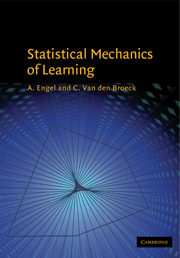Book contents
- Frontmatter
- Contents
- Preface
- 1 Getting Started
- 2 Perceptron Learning – Basics
- 3 A Choice of Learning Rules
- 4 Augmented Statistical Mechanics Formulation
- 5 Noisy Teachers
- 6 The Storage Problem
- 7 Discontinuous Learning
- 8 Unsupervised Learning
- 9 On-line Learning
- 10 Making Contact with Statistics
- 11 A Bird's Eye View: Multifractals
- 12 Multilayer Networks
- 13 On-line Learning in Multilayer Networks
- 14 What Else?
- Appendices
- Bibliography
- Index
3 - A Choice of Learning Rules
Published online by Cambridge University Press: 05 June 2012
- Frontmatter
- Contents
- Preface
- 1 Getting Started
- 2 Perceptron Learning – Basics
- 3 A Choice of Learning Rules
- 4 Augmented Statistical Mechanics Formulation
- 5 Noisy Teachers
- 6 The Storage Problem
- 7 Discontinuous Learning
- 8 Unsupervised Learning
- 9 On-line Learning
- 10 Making Contact with Statistics
- 11 A Bird's Eye View: Multifractals
- 12 Multilayer Networks
- 13 On-line Learning in Multilayer Networks
- 14 What Else?
- Appendices
- Bibliography
- Index
Summary
The Gibbs rule discussed in the previous chapter characterizes the typical generalization behaviour of the students forming the version space. It is hence well suited for a general theoretical analysis. For a concrete practical problem it is, however, hardly the best choice and there is a variety of other learning rules which are often more direct and may also show a better performance. The purpose of this chapter is to introduce a representative selection of these learning rules, to discuss some of their features, and to compare their properties with those of the Gibbs rule.
The Hebb rule
The oldest and maybe most important learning rule was introduced by D. Hebb in the late 1940s. It is, in fact, an application at the level of single neurons of the idea of Pavlov coincidence training. In his famous experiment, Pavlov showed how a dog, which was trained to receive its food when, at the same time, a light was being turned on, would also start to salivate when the light alone was lit. In some way, the coincidence of the two events, food and light, had established a connection in the brain of the dog such that, even when only one of the events occurred, the memory of the other would be stimulated. The basic idea behind the Hebb rule [32] is quite similar: strengthen the connection of neurons that fire together.
- Type
- Chapter
- Information
- Statistical Mechanics of Learning , pp. 33 - 48Publisher: Cambridge University PressPrint publication year: 2001



